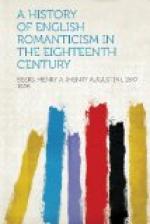[37] Pope’s, “Snatch a grace beyond the
reach of art.”
—Essay on Criticism.
[38] “History of England,” Vol. II. p. 739.
CHAPTER IV.
The Landscape Poets
There is nothing necessarily romantic in literature that concerns itself with rural life or natural scenery. Yet we may accept, with some qualification, the truth of Professor McClintock’s statement, that the “beginning and presence of a creative, romantic movement is almost always shown by the love, study, and interpretation of physical nature."[1] Why this should be true, at all events of the romantic movement that began in the eighteenth century, is obvious enough. Ruskin and Leslie Stephen have already been quoted, as witnesses to the fact that naturalism and romanticism had a common root: the desire, namely, to escape into the fresh air and into freer conditions, from a literature which dealt, in a strictly regulated way, with the indoor life of a highly artificial society. The pastoral had ceased to furnish any relief. Professing to chant the praises of innocence and simplicity, it had become itself utterly unreal and conventional, in the hands of cockneys like Philips and Pope. When the romantic spirit took possession of the poetry of nature, it manifested itself in a passion for wildness, grandeur, solitude. Of this there was as yet comparatively little even in the verse of Thomson, Shenstone, Akenside, and Dyer.
Still the work of these pioneers in the “return to nature” represents the transition, and must be taken into account in any complete history of the romantic movement. The first two, as we have seen, were among the earliest Spenserians: Dyer was a landscape painter, as well as a poet; and Shenstone was one of the best of landscape gardeners. But it is the beginnings that are important. It will be needless to pursue the history of nature poetry into its later developments; needless to review the writings of Cowper and Crabbe, for example,—neither of whom was romantic in any sense,—or even of Wordsworth, the spirit of whose art, as a whole, was far from romantic.
Before taking up the writers above named, one by one, it will be well to notice the general change in the forms of verse, which was an outward sign of the revolution in poetic feeling. The imitation of Spenser was only one instance of a readiness to lay aside the heroic couplet in favor of other kinds which it had displaced, and in the interests of greater variety. “During the twenty-five years,” says Mr. Goss, “from the publication of Thomson’s ‘Spring’ [’Winter’] in 1726, to that of Gray’s ‘Elegy’ in 1751, the nine or ten leading poems or collections of verse which appeared were all of a new type; somber, as a rule, certainly stately, romantic in tone to the extreme, prepared to return, ignorantly indeed, but with respect, to what was ‘Gothic’ in manners, architecture, and language; all showing




